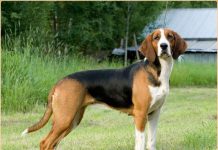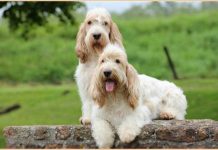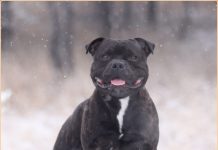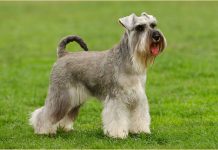The West Siberian Laika closely resembles to wolf in appearance. This is because the breed has wolf ancestors in its bloodline. Not only in appearance but they have personality and temperament as that of a wolf.
This breed is challenging to keep even for an experienced owner. But if you’re a confident to domesticate this fierce and beautiful breed, nobody could stop you from owning one. Just like spitz breed, the dog has thick fur, erected ears and pointed muzzle.
It is believed that the West Siberian Laika was developed by indigenous tribe of Russia named Mansi and Khanty. It is one of the three Laika breeds developed by them, the other being, Russo-European Laika and the East Siberian Laika.
This breed was used for hunting purpose. Its thick fur and wild behavioral traits made it suitable to hunt in extreme cold condition. If trained well, this breed can be incredible addition to your family.
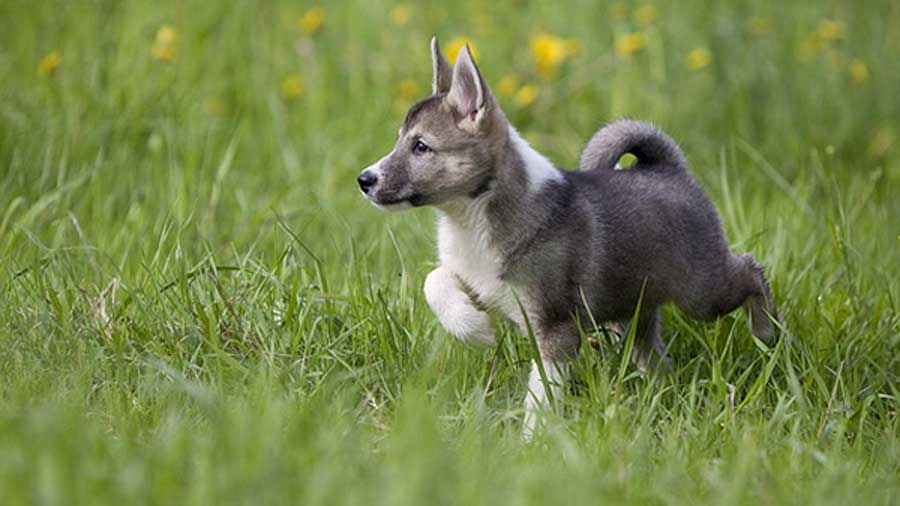
Origin
Generally, all the spitz type dogs are closely related to wolves. This breed has originated from North Ural and West Siberia. This breed was developed by two native tribes of Russia Voguls and Ostyak (Mansi and Khanty). It is a descendant of wolves and indigenous spitz type breeds.
Those two tribes used the dogs for hunting big animals. It became like part and parcel of their life as they were highly dependent upon this dog for food and survival. The intelligence and versatility of this dog made perfect companion to people of Siberia. Because of limited gene pool, this breed has still intact the nature and appearance of ancient Laika.
West Siberian Laika Characteristics
- The breed belongs to Siberia and is a hunt dog.
- It is aggressive, protective, territorial and independent nature breed.
- Lifespan of this breed is 14-16 years.
- The dog stands at a height of 56-61 cm.
- It weighs around 16-23 kg.
- The dog comes in black, grey, sable, salt and pepper and white color.
- Average price of the breed is $600 – $800 USD.
- The breed is not suitable for apartment life. It is active indoors and requires space to thrive.
- The dog is not barky and will bark only when necessary.
- It is an energetic breed and needs lot of exercise to thrive.
- It is not a hypoallergenic breed.
- The breed sheds a lot of hair. Be ready to vacuum often.
- It makes excellent watch dog as well as guard dog.
- The dog requires firm owner to train it.
Appearance
The dog looks similar to wolf and other spitz type breed. It is large to medium sized breed with strongly built up body. The dog has wedged shaped head and pointed muzzle which make it face triangular shaped. It has scissor bite which is sharp and capable of ripping apart prey.
It has medium sized expressive and brown colored eyes. Its ears are always erect, pointed and small to medium size. It has typical spitz-type tail. The dog has a bushy tail which curves over its back. The dog has well-muscled legs. This breed gives the expression of fierceness and intelligence.
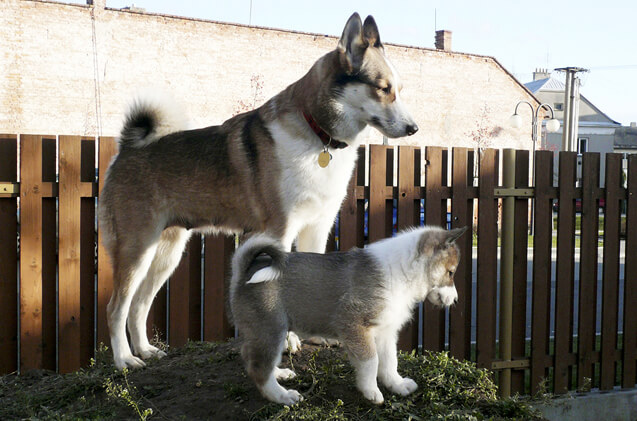
Size and Weight
Male breed stands at a height of 22-24 inches and female breed stands at a height of 20-23 inches. Male should weigh around 16-23 kg and female should be 14-20 kg.
Coat and Color
The dog has thick double coat which helps it to withstand extreme cold condition. The topcoat has straight guard hairs which is frizzy to touch. Undercoat is smooth and soft to touch.
Dogs raised in cold countries have thicker and longer hair than those who are domesticated in relatively warm countries. General colors of this breed are wolf gray, pale red and white.
Temperament
- Personality – Before buying this breed, you must prepare yourself to raise a wild dog. It is bold, courageous and will not always listen to your commands. The dog is immensely observant in nature. It will try to outsmart and tricks its master, to test their owner’s mood. They are not a kind of dog to be left alone in a backyard. Like humans, dogs are social in nature and want to be with people. The dog cherishes freedom so keep it off leash inside home. They are also naturally protective of their family.
- Behavior – This breed is intolerant towards other animal. It will fight with other dogs not to kill them but to show dominance over them. They tend to be aloof and suspicious of strangers. With family children, they are playful and protective. But with neighbor’s children, they might not get along. Small animals like rabbits, mouse, squirrel, cats are irresistible to Laika and it will not leave the opportunity to hunt them.
- Activities Requirement – Apart from being a hunt dog, it excels in agility, endurance and strength related activities. Give this breed intensive exercise so that it can burn its extra energy. The dog can work all day so it would be better if you give it responsibility of any task. Apart from daily exercise, spend lots of time with dog to avoid unwanted behavior.
- Trainability – The dog is intelligent which means it can easily learn skills but also has mind of its own. You need to be “alpha” in dog’s mind only then it will follow you and listen to your commands. Be firm but gentle while training them. Treats and appreciations work wonders in making them learn lesson. Make sure to socialize the dog at an early age so that they can be tolerant of new people and animals.

Feeding
You need to feed this dog barf diet. Barf is an acronym of biological appropriate raw food. You can give raw ham and egg to this dog. Deer meet provides a good supplement of minerals and vitamins to this dog. You should keep in mind that dogs are carnivorous animals and they love bones and meat. You can also give them fresh chicken and grains to eat.
Lifespan
Life expectancy of this breed is 14-16 years.
Health Issues
It is not hypoallergenic breed. Because of limited gene pool, it is a healthy dog with no major health issues.
Grooming
This breed keeps themselves clean, so there is no requirement of bathing and trimming its hair regularly. Only Few times a year they should be bath. They shed hair throughout the year; heavy shedding is twice a year.
You are required to comb the hair of this dog daily to avoid mess. This dog develops fungus on its skin if not brush. You need to brush the dog’s skin with bristled brush. Rub the dog’s skin with chamois to get lustrous skin free of debris.
Habitat
The dog can live in cold as well as warm climate equally well because of its unique adaptability of coat. This breed tends to be active and needs space to thrive.
Pet Names
- Goofy
- Linda
- Sony
- Willy
- Adam
Things To Consider Before Buying
Pros
- The dog makes excellent guard dog and watch dog.
- It has outstanding hunting abilities.
- Grooming needs of the dog is infrequent and simple.
Cons
- Sheds a great deal of hair and is not hypoallergenic.
- It requires firm leadership for training.
- The breed has intact the wildness of wolf.


